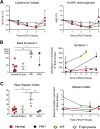Human ex vivo lung perfusion: a novel model to study human lung diseases
- PMID: 33436736
- PMCID: PMC7804395
- DOI: 10.1038/s41598-020-79434-4
Human ex vivo lung perfusion: a novel model to study human lung diseases
Abstract
Experimental animal models to predict physiological responses to injury and stress in humans have inherent limitations. Therefore, the development of preclinical human models is of paramount importance. Ex vivo lung perfusion (EVLP) has typically been used to recondition donor lungs before transplantation. However, this technique has recently advanced into a model to emulate lung mechanics and physiology during injury. In the present study, we propose that the EVLP of diseased human lungs is a well-suited preclinical model for translational research on chronic lung diseases. Throughout this paper, we demonstrate this technique's feasibility in pulmonary arterial hypertension (PAH), idiopathic pulmonary fibrosis (IPF), emphysema, and non-disease donor lungs not suitable for transplantation. In this study, we aimed to perfuse the lungs for 6 h with the EVLP system. This facilitated a robust and continuous assessment of airway mechanics, pulmonary hemodynamics, gas exchange, and biochemical parameters. We then collected at different time points tissue biopsies of lung parenchyma to isolate RNA and DNA to identify each disease's unique gene expression. Thus, demonstrating that EVLP could successfully serve as a clinically relevant experimental model to derive essential insights into pulmonary pathophysiology and various human lung diseases.
Conflict of interest statement
The authors declare no competing interests.
Figures








Similar articles
-
Ex-vivo lung perfusion.Curr Opin Anaesthesiol. 2020 Feb;33(1):50-54. doi: 10.1097/ACO.0000000000000804. Curr Opin Anaesthesiol. 2020. PMID: 31688085 Review.
-
Standard donor lung procurement with normothermic ex vivo lung perfusion: A prospective randomized clinical trial.J Heart Lung Transplant. 2017 Jul;36(7):744-753. doi: 10.1016/j.healun.2017.02.011. Epub 2017 Feb 20. J Heart Lung Transplant. 2017. PMID: 28314503 Clinical Trial.
-
The effects of hydrogen gas inhalation during ex vivo lung perfusion on donor lungs obtained after cardiac death.Eur J Cardiothorac Surg. 2015 Oct;48(4):542-7. doi: 10.1093/ejcts/ezv057. Epub 2015 Mar 6. Eur J Cardiothorac Surg. 2015. PMID: 25750008
-
Technique for prolonged normothermic ex vivo lung perfusion.J Heart Lung Transplant. 2008 Dec;27(12):1319-25. doi: 10.1016/j.healun.2008.09.003. J Heart Lung Transplant. 2008. PMID: 19059112
-
Progress of Clinical Application for Ex Vivo Lung Perfusion (EVLP) in Lung Transplantation.Methods Mol Biol. 2020;2204:217-224. doi: 10.1007/978-1-0716-0904-0_19. Methods Mol Biol. 2020. PMID: 32710328 Review.
Cited by
-
Novel Insights into the Therapeutic Potential of Lung-Targeted Gene Transfer in the Most Common Respiratory Diseases.Cells. 2022 Mar 12;11(6):984. doi: 10.3390/cells11060984. Cells. 2022. PMID: 35326434 Free PMC article. Review.
-
The Respiratory Tract Microbiome and Human Health.Microb Biotechnol. 2025 May;18(5):e70147. doi: 10.1111/1751-7915.70147. Microb Biotechnol. 2025. PMID: 40293161 Free PMC article. Review.
-
In Vitro Lung Models and Their Application to Study SARS-CoV-2 Pathogenesis and Disease.Viruses. 2021 Apr 28;13(5):792. doi: 10.3390/v13050792. Viruses. 2021. PMID: 33925255 Free PMC article. Review.
-
Crystal ribcage: a platform for probing real-time lung function at cellular resolution.Nat Methods. 2023 Nov;20(11):1790-1801. doi: 10.1038/s41592-023-02004-9. Epub 2023 Sep 14. Nat Methods. 2023. PMID: 37710017 Free PMC article.
-
State of the Art Modelling of the Breast Cancer Metastatic Microenvironment: Where Are We?J Mammary Gland Biol Neoplasia. 2024 Jul 16;29(1):14. doi: 10.1007/s10911-024-09567-z. J Mammary Gland Biol Neoplasia. 2024. PMID: 39012440 Free PMC article. Review.
References
-
- Liu, T., De Los Santos, F. G. & Phan, S. H. The bleomycin model of pulmonary fibrosis. Methods Mol. Biol.1627, 27–42. 10.1007/978-1-4939-7113-8_2 (2017). - PubMed
-
- Eltom, S., Stevenson, C. & Birrell, M. A. Cigarette smoke exposure as a model of inflammation associated with COPD. Curr. Protoc. Pharmacol.C10.1002/0471141755.ph0564s60 (2013). - PubMed
Publication types
MeSH terms
Grants and funding
LinkOut - more resources
Full Text Sources
Other Literature Sources
Medical
Molecular Biology Databases

